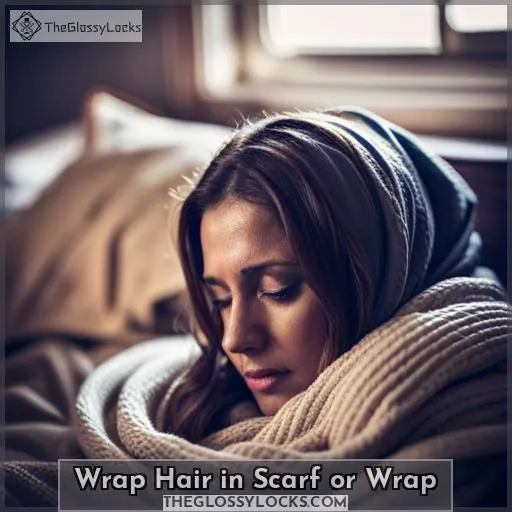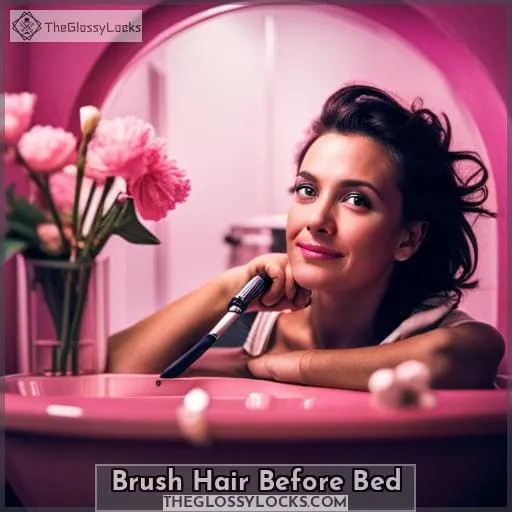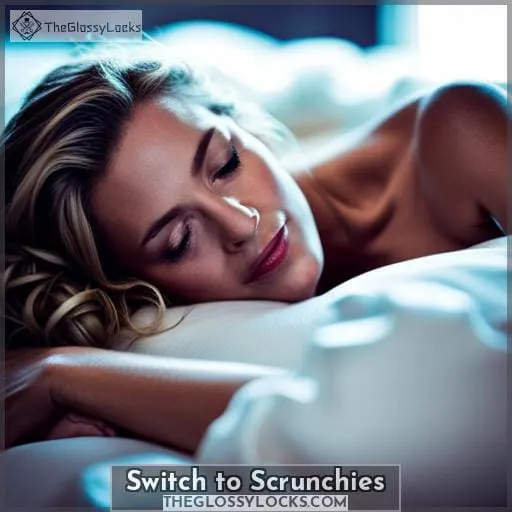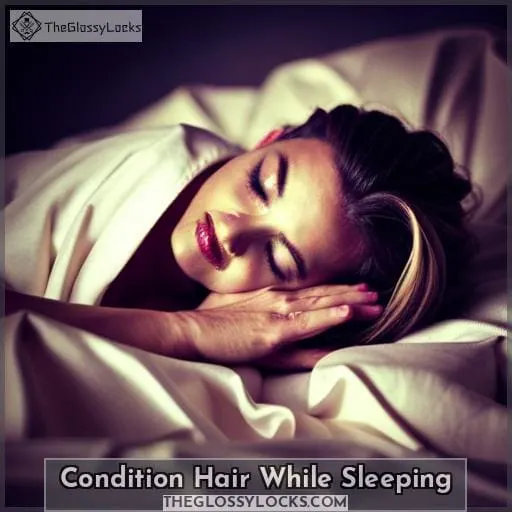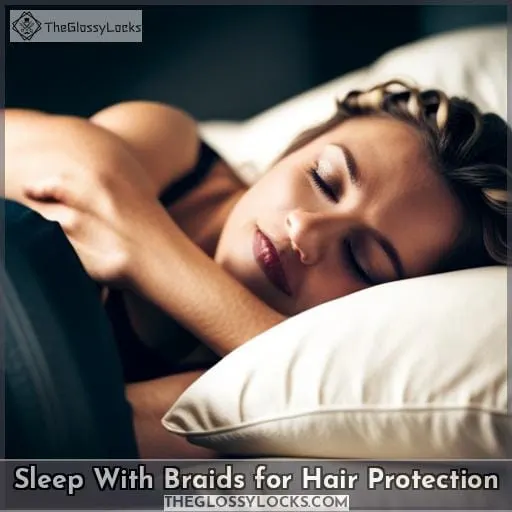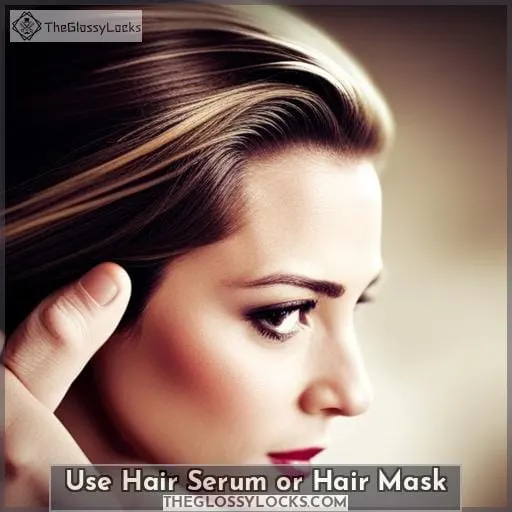This site is supported by our readers. We may earn a commission, at no cost to you, if you purchase through links.

Did you know that the type of pillowcase you use can make a difference? Learn why silk or satin pillowcases are a game-changer for reducing friction and preventing breakage.
From timing your showers to using hair serums, these expert-approved strategies will help keep your hair protected and looking its best even while you catch some z’s.
Don’t let overnight damage cramp your style – take control of your hair health now!
Table Of Contents
- Key Takeaways
- Use Silk or Satin Pillowcases
- Time Your Showers for Hair Protection
- Wrap Hair in Scarf or Wrap
- Brush Hair Before Bed
- Switch to Scrunchies
- Protect Ends With Essential Oil
- Condition Hair While Sleeping
- Sleep With Braids for Hair Protection
- Use Hair Serum or Hair Mask
- Consider Environmental Factors
- Frequently Asked Questions (FAQs)
- Can sleeping with wet hair cause damage?
- How can I protect my hair from breakage while sleeping?
- What are some alternative ways to protect my hair while sleeping besides using a silk pillowcase?
- Are there any specific hair products I should use before bed to protect my hair?
- How can environmental factors affect the health of my hair while I sleep?
- Conclusion
Key Takeaways
- Use a silk or satin pillowcase and wrap your hair in a scarf or wrap to protect it from damage.
- Switch to scrunchies and protect your ends with essential oil to reduce damage and breakage.
- Sleep with braids or use hair serum/mask to provide hair protection and nourishment.
- Consider environmental factors such as drying your hair before bed and using a fan or humidifier to maintain optimal moisture levels.
Use Silk or Satin Pillowcases
To protect your hair while you sleep, consider using silk or satin pillowcases.
These smooth and slippery fabrics are excellent for hair health as they reduce friction and prevent damage.
Unlike cotton pillowcases that can cause friction and lead to tangles, silk and satin create a gentle surface for your hair to rest on throughout the night.
The smoothness of these materials helps to maintain the integrity of your strands by reducing breakage caused by rubbing against rougher surfaces.
Additionally, silk or satin pillowcases don’t absorb moisture from your hair like cotton does, allowing it to retain its natural oils and hydration levels overnight.
By investing in a silk or satin pillowcase, you can wake up with smoother, healthier-looking locks without worrying about unnecessary damage during sleep.
Time Your Showers for Hair Protection
When it comes to protecting your hair while sleeping, it’s important to consider the timing of your showers. The way you shower can have a significant impact on the health and condition of your hair.
- Morning vs. Night Showers:
- If possible, try to shower in the morning rather than at night. This allows enough time for your hair to dry completely before bed, reducing the risk of breakage.
- Hot vs. Cold Water:
- Opt for lukewarm or cool water instead of hot water when washing your hair in the shower. Hot water can strip away natural oils from our scalp and leave our strands dry and prone to damage.
- Long vs Short Showers:
- Keep showers short and efficient as spending too much time in hot steamy baths can dehydrate both skin &hair
By considering these factors during showering,you will be taking proactive steps towards protecting against potential harm such as damage,breakage,and frizz that may occur if not careful.
Wrap Hair in Scarf or Wrap
Wrap your hair in a scarf or wrap to protect it while you sleep.
Choosing the right type of scarf or wrap is essential for keeping your hair safe and minimizing damage. Silk scarves are highly recommended as they’re gentle on the hair, reduce friction, and help prevent tangles.
To properly wrap your hair, start by brushing it to remove any knots or tangles. Then, fold the scarf into a triangle shape and place it over your head with the point facing forward. Take each end of the scarf and tie them securely at the back of your head, making sure not to tie too tightly as this can cause tension on your scalp.
The duration you should keep your hair wrapped depends on personal preference but overnight is generally recommended for optimal protection.
You may want to experiment with different wrapping techniques until you find one that works best for you.
By following these tips on how to wrap your hair, you can help protect it from damage and keep it looking its best.
Brush Hair Before Bed
To ensure your hair stays healthy and tangle-free while you sleep, the next essential tip is to brush your hair before bed.
Whether your hair is wet or dry, brushing it every night can help prevent knots and tangles from forming overnight.
If you prefer to shower in the evening, make sure to brush your hair before stepping into the shower. This will detangle any knots and allow for easier washing and styling later on. After showering, gently pat dry with a towel and then use a wide-toothed comb or detangling brush to remove any remaining knots.
On nights when you don’t wash your hair, still take a moment to brush through it before bedtime.
Remember that brushing should be done gently yet firmly enough to effectively remove tangles without causing excessive breakage or damage to your strands. By incorporating this simple step into your nightly routine, you’ll promote healthier-looking locks that are easier to manage in the morning.
Switch to Scrunchies
To protect your hair while sleeping, make the switch to scrunchies.
Unlike traditional hair elastics, scrunchies are better for your hair and scalp as they cause less damage and breakage.
The soft fabric of a scrunchie is gentle on your strands, preventing them from being pulled or damaged during the night.
Scrunchies also eliminate the risk of dents or creases in your hair that can occur with tight ponytails or buns held by regular elastics.
By using a scrunchie instead, you can wake up with smooth and tangle-free locks without any knots to undo in the morning.
This simple change in accessory choice can go a long way in protecting against potential damage caused by other types of ties that may contribute to increased breakage and even hair loss over time.
Protect Ends With Essential Oil
Now that you’ve learned about the benefits of switching to scrunchies, it’s time to focus on another essential tip for protecting your hair while sleeping: using essential oil to protect your ends.
Essential oils can provide nourishment and hydration, helping to repair and strengthen damaged hair. When choosing an essential oil for your hair, look for options like lavender or rosemary as they’re known for their stimulating properties that promote hair growth.
To apply the essential oil, start by diluting a few drops in a carrier oil such as coconut or jojoba oil. Gently massage this mixture onto the ends of your hair before bed, focusing on any areas that are dry or prone to split ends.
As with any product applied directly to the scalp or strands, it’s important not to overdo it. Using an essential-oil-infused serum once or twice a week is generally sufficient unless advised otherwise by a professional stylist.
By incorporating this step into your nighttime routine along with other protective measures like using silk pillowcases and avoiding heat styling tools before bed,
you’ll be well on your way towards achieving healthy-looking locks even while you sleep.
Condition Hair While Sleeping
Condition your hair while you sleep by applying a nourishing overnight treatment or deep conditioner.
Overnight treatments are designed to deeply penetrate the hair shaft, providing intense moisture and repairing any damage. Look for products labeled as leave-in conditioners or overnight masks that can be applied to damp or dry hair before bed.
These products often contain ingredients such as argan oil, which is known for its nourishing properties.
To apply, simply distribute the product evenly throughout your strands using your fingers or a wide-toothed comb, focusing on the mid-lengths and ends of your hair where it tends to be drier.
In addition to overnight treatments, you can also consider using pre-shampoo treatments like leave-in conditioners or oils before bed. These products help protect against breakage caused by friction from tossing and turning during sleep.
By incorporating these conditioning methods into your nighttime routine, you’ll wake up with softer, more manageable locks in the morning – ready to take on whatever challenges come your way!
Sleep With Braids for Hair Protection
Wrap your hair in braids before bed to protect it from damage and maintain its style.
Braiding your hair at night can offer multiple benefits, especially when done correctly.
When choosing between loose braids or tight braids, opt for looser styles to prevent unnecessary tension on the scalp and minimize breakage.
How long you should sleep with braids depends on personal preference and the desired outcome; some people prefer wearing them overnight while others may choose to wear them for a couple of days.
To protect your braided hairstyle from frizz, consider using a silk scarf or bonnet to cover your head while you sleep.
For those with fine hair, smaller sections and tighter plaits can help create more volume once the braid is released in the morning.
If you have curly hair, try incorporating twists into your braid pattern for added definition without compromising curl formation.
Use Hair Serum or Hair Mask
Apply a hair serum or hair mask before bed to nourish and protect your strands while you sleep.
- Use the right amount of serum: Apply a small amount of hair serum, focusing on the ends and avoiding the roots. Using too much can weigh down your hair.
- How often to use: It depends on your specific needs, but using a hair serum or mask once or twice a week is usually sufficient for most people.
- Best Hair Serums: Look for serums that contain ingredients like argan oil, coconut oil, or keratin for added hydration and repair benefits.
- Hair Serum vs. Mask: While both serums and masks provide nourishment, serums are lighter in texture and great for everyday use. Masks are more intense treatments that can be used once in a while when you need extra care.
- Leave-in Hair Serum: If you prefer leaving product in overnight without rinsing it out, opt for leave-in serums specifically designed for this purpose.
By incorporating these steps into your nighttime routine with the right products suited to your unique needs will help keep your locks healthy and strong.
Consider Environmental Factors
When it comes to protecting your hair while sleeping, it’s important to consider environmental factors.
One factor to consider is the type of pillowcase you use. Silk or satin pillowcases are recommended as they create less friction and reduce damage to your hair.
Additionally, you can also protect the ends of your hair by applying a nourishing oil before bed.
Lastly, considering factors such as humidity levels in your bedroom can also help keep your hair healthy while you sleep.
Silk vs. satin pillowcase
Protect your hair while sleeping by considering the environmental factors, such as choosing between a silk or satin pillowcase.
Both options have their advantages and disadvantages.
A satin pillowcase is often more affordable and widely available, but it may not provide the same level of smoothness as silk.
Silk pillowcases are known for reducing friction on hair, preventing breakage, and maintaining moisture in curly or dry hair types.
Ultimately, the choice between silk and satin depends on your specific needs and preferences.
Protecting ends with oil
To ensure maximum protection for your hair while sleeping, it’s important to consider environmental factors and protect the ends with nourishing oils.
When choosing an oil for your hair ends, you can also consider using castor oil, which is rich in ricinoleic acid for hair growth, opt for options like argan oil or coconut oil which are known to be great moisturizers.
Apply a small amount of the chosen oil by warming it up in your hands and then gently running it through the ends of your hair before bedtime.
Using a satin or silk pillowcase can reduce friction and prevent split ends, as sleeping on cotton can cause damage. This will help to prevent dryness and split ends caused by friction against pillows during sleep.
Repeat this process every few nights or as needed based on how dry your hair is.
Environmental factors to conside
To protect your hair while sleeping, consider the environmental factors in your bedroom.
- Dry your hair before bed to prevent breakage and damage.
- Use a fan or humidifier to maintain optimal moisture levels in the air and avoid dryness.
- Avoid heat styling tools on wet hair as it can cause further damage.
- Get regular trims to prevent split ends and wash your hair less frequently to reduce dryness.
Frequently Asked Questions (FAQs)
Can sleeping with wet hair cause damage?
Sleeping with wet hair can cause damage.
Wet hair is more susceptible to breakage and can lead to frizz and split ends.
Ensure your hair is completely dry before going to bed for healthier, stronger locks.
How can I protect my hair from breakage while sleeping?
Protect your hair from breakage while sleeping by using a silk pillowcase or wrapping it in a scarf.
Detangle before bed, apply nourishing treatments, and try protective hairstyles like braids.
Sleep with power and wake up to beautiful hair.
What are some alternative ways to protect my hair while sleeping besides using a silk pillowcase?
To protect your hair while sleeping without a silk pillowcase, try wrapping it in a satin or silk scarf.
Alternatively, you can opt for protective hairstyles like braids or buns to minimize damage and maintain healthy hair.
Are there any specific hair products I should use before bed to protect my hair?
To protect your hair while sleeping:
- Apply a nourishing treatment and lightweight serum.
- Sleep on a satin or silk pillowcase to reduce friction.
- Try protective hairstyles like braids or wrap your hair up before bed.
How can environmental factors affect the health of my hair while I sleep?
Environmental factors, such as the temperature and humidity in your bedroom, can impact the health of your hair while you sleep.
Using a fan or humidifier can help create an optimal environment for keeping your hair hydrated and protected.
Conclusion
Incorporate these essential tips into your nighttime routine to protect your hair while sleeping and wake up with gorgeous locks.
Switch to silk or satin pillowcases to reduce friction and prevent breakage.
Time your showers properly to avoid damage.
Wrap your hair in a scarf or wrap to keep it protected throughout the night.
Brush your hair before bed and switch to scrunchies to minimize damage.
Use essential oils to protect your ends and condition your hair while you sleep.
Consider environmental factors that may impact your hair health.
Take control of your hair health now and say goodbye to overnight damage.



